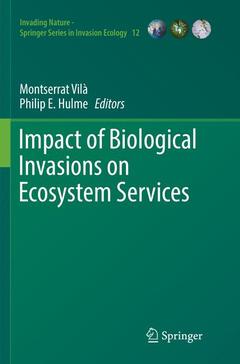Description
Impact of Biological Invasions on Ecosystem Services, Softcover reprint of the original 1st ed. 2017
Invading Nature - Springer Series in Invasion Ecology Series, Vol. 12
Coordinators: Vilà Montserrat, Hulme Philip E.
Language: English
Subjects for Impact of Biological Invasions on Ecosystem Services:
Publication date: 06-2018
Support: Print on demand
Publication date: 02-2017
Support: Print on demand
Description
/li>Contents
/li>Comment
/li>
The book presents an analysis of the ecological, economic and social threats posed by the introduction and spread of non-native species. It provides a comprehensive description of impacts of non-native species from all five kingdoms of life across all ecosystems of the world. New insights into the impacts arising from biological invasions are generated through taking an ecosystem services perspective. This work highlights that management of biological invasions is needed not only to sustain biodiversity and the environment, but also to safeguard productive sectors such as agriculture, forestry and fisheries, as well as to preserve human health and well-being.
1. Introduction.- PART I: Introduction.- 2. Changes in primary production and carbon sequestration after invasion.- 3. Modification of habitat quality and stability by non-native species.- 4. Alteration of nitrogen cycling as a result of invasion.- 5. Hydrological impacts of biological invasions.- Part II: Impacts on provisioning services.- 6.Decreases in crop production by non-native weeds, pests and pathogens.- 7. Impact of non-native pests and pathogens on forestry.- 8. Interference with aquaculture and fisheries.- 9. Impacts of non-native species on livestock and genetic resources.- PART III: Impacts on regulating services.- 10. Displacement and local extinction of native and endemic species.- 11. Infections and diseases in wildlife by non-native organisms.- 12. Non-target effects of biological control agents.- 13. Disruption of pollinator services.- 14. Impact of invasions on water quality in marine and freshwater environments.- 15. Damage to infrastructures.- 16. Alteration of disturbance regimes.- PART IV: Impacts on cultural services and human well-being.- 17.Spread of vectored non-native human diseases.- 18. Impacts of non-native animal toxins and injuries to human health.- 19. Use of non-native species in developing economies and for poverty alleviation.- 20. Non-native species and the aesthetics of nature.- PART V: Synthesis.
Equips readers with ready access to the latest thinking in ecosystem services as relating to biological invasions
Describe a wide range of impacts by non-native microorganisms on a wide range of species including humans
Integrates research dispersed across disciplines that is essential for best management of biological invasions
Provides a comprehensive information system of the worst invaders to different productive and socio-economic sectors
These books may interest you

Handbook of Alien Species in Europe 210.99 €



